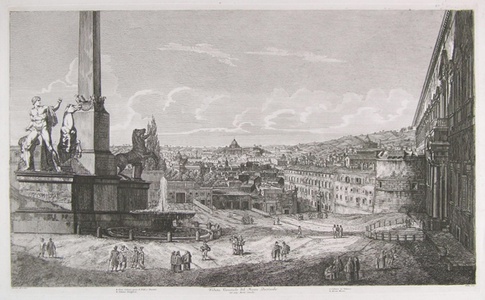| Method | Etching with engraving |
| Artist | Luigi Rossini |
| Published | Rossini dis. e inc. Roma 1822 |
| Dimensions | Image 415 x 697 mm, Plate 440 x 710 mm, Sheet 532 x 745 mm |
| Notes |
Inscription reads: 'A. Gran Colossi, opera di Fidia e Prasitele. B. Palazzo Pontificio. C. S. Pietro in Vaticano. D. Monte Mario.' Plate 15 from Le Antichita Romane, ossia Raccolta della piu interessanti Vedute di Roma Antica, depicting a general view of the Quirinal Hill, framed by the facade of the Palazzo Quirinale on the right and the colossal statues of the Horse Tamers on the left. In addition to these two monuments, the Vatican Basilica of St Peter and the Monte Mario, Rome's highest hill, appear in the background and are labelled and described. Rossini's plate provides an intermediate view of the development of the Quirinal Hill between the Vedute of Piranesi and the present day. Rossini's view is almost exactly the same as that of Piranesi's, but for the addition of the obelisk that was erected on the piazza in 1783-6. The Quirinal Palace was constructed in 1583 as the summer palace of Pope Gregory XIII. Following the creation of the Kingdom of Italy, the Palace served as the residence of the royal family, and today is the principal residence of the Italian Presidents. It stands on the Quirinal Hill, a location which in Roman times was the site of the Temples of Flora and Quirinus, as well as the Baths of Constantine. The colossal statues of the Horse Tamers originally came from this bath complex, and were identified erroneously in Late Antiquity as the work of the famous Greek sculptor Praxiteles. The vernacular title for the Quirinal Hill that Rossini mentions in the subtitle to this view, the Monte Cavallo ('Horse Mountain'), alluded to these celebrated statues. Le Antichita Romane, ossia Raccolta della piu interessanti Vedute di Roma Antica was Rossini's largest series of engravings, and the most popular with his clients. The 101 plates of views of the remains of Ancient Rome were completed between 1819 and 1823. The influence of Piranesi and the other great etchers of the 18th century is immediately apparent when looking at Rossini's work. In some cases, Rossini's perspectives match almost exactly those executed by Piranesi in the previous century, with an equal attention to architectural detail. As a result, the viewer is provided with a fascinating record of the changes wrought on Rome's most famous monuments in the time between the two artists. Luigi Rossini (1790-1857) was an Italian painter and etcher. Born in Ravenna, he studied art and architecture at the Academy of Bologna with Antonio Giuseppe Basoli and Giovanni Antonio Antolini. He graduated in 1813. Similarly to Giovanni Battista Piranesi, Rossini is best known for etchings of classical Roman architecture including the Pantheon, the Colosseum, the Appian Way, the Temple of Peace, and the Golden House of Nero. Rossini was also influenced by more rural settings, and produced etchings of the landscape surrounding Rome. His first series of views were published in 1814. He began his Roman antiquities series in 1819, completing 101 large folio plates which were published in Rome in 1825. Condition: Excellent clean impression. Light staining to top right margins of sheet, not affecting plate or image. |
| Framing | unmounted |
| Price | £1,400.00 |
| Stock ID | 31345 |

